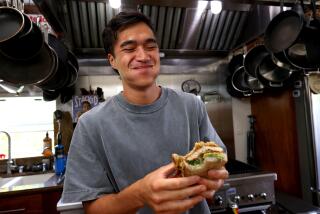Roger Hong, 65; landlord tried to rejuvenate Chinatown by luring young, creative tenants
Roger Hong hated the cliche that Chinatown was insular, dirty and only sought out by visitors for cheap trinkets and greasy food.
Five years ago, when he was given the opportunity to bring new businesses into his family’s buildings in Chinatown’s Central Plaza -- the landmark square in the 900 block of Broadway anchored by its famous neon-tinted east gate -- he invited a hip, Japanese American boutique, a purveyor of underground toy art and a bohemian-minded Vietnamese cafe that would cater to the many artists that have flooded the neighborhood.
It was a sizable risk for Hong, because the business district was still little more than a weekend tourist attraction. Many old-timers wondered why he didn’t simply lease the spaces to the same-old vendors selling back scratchers, silk robes and lucky trees.
“He didn’t want to just fill up space,” said George Yu, executive director of the Chinatown Business Improvement District. “He wanted tenants he could believe in.”
Hong died of lung cancer Friday at Good Samaritan Hospital in Los Angeles, said his longtime friend, Carol Courtenay. He was 65.
Hong was a founding board member of the improvement district and a longtime property owner. His father was a pioneering Chinese American lawyer who helped build the so-called New Chinatown 68 years ago.
Friends, relatives and Chinatown stakeholders say Hong’s insistence on encouraging young, creative Asian Americans to come into the neighborhood will reinvigorate Chinatown. And in some ways, it already has. Central Plaza comes to life on many weekends with the sound of dance music and hip-hop blaring from neighboring bars. Hipsters flock to the nearby galleries and the boutiques in buildings formerly owned by Hong’s family.
Hong wanted more cohesion in the business community. He implored others to stay open later to attract evening crowds. He wanted store owners to consider modernizing. Often, his pleas were ignored. Though Hong was respected for his father’s accomplishments, he still struggled to persuade Chinatown’s old guard. It did not help that he could not speak Chinese.
“Respect is a big part of the culture,” Yu said. “Roger grew up with the old guard, calling them ‘auntie’ and ‘uncle,’ but it was difficult trying to do business with them. Some of these tenants were paying nominal rent and weren’t trying to improve their businesses.”
Hong’s father, You Chung Hong, was the first Chinese American to pass the California bar exam. He became a legendary immigration attorney who helped many Chinese attain citizenship.
When the old Chinatown was forcibly leveled to make way for the city’s central train terminal, Union Station, You Chung Hong was part of a coalition of community leaders that helped design and build New Chinatown, which opened in 1938.
At the root of the son’s quest to bring Chinatown back to prominence was a deep appreciation of the neighborhood’s history and his father’s integral role in it, people close to Hong said.
This proud past came to light two years ago, when Hong sold the properties and began emptying his father’s office. The two-story building was a goldmine of artifacts trapped in time. There was a 1930s-era typewriter, Art Deco furniture and thousands of dusty files that documented the arrival of Chinese from before World War II. Hong donated the archive and antiques to the Huntington Library.
He decided to sell the buildings because of his illness.
He vetted potential buyers, seeking those dedicated to advancing Chinatown’s culture. He turned down higher offers and sold the properties to an architect who shares Hong’s appreciation for mid-century modern design.
The buyer, Richard Liu of DSR Design, promised to restore the buildings, paying special attention to You Chung Hong’s office.
“I wouldn’t have sold the building if I didn’t find the right person,” Hong told The Times in 2005. “We have a culture here in L.A. that needs to be preserved.”
Though he spent much time in Chinatown visiting his father, Hong grew up in the tonier setting of Country Club Park near what is now Koreatown. When he attended Los Angeles High School, he was one of only three Chinese Americans in his class, a classmate said.
From an early age, Hong expressed a flair for drawing and sketching. He went directly to architecture school at USC after graduating from high school. He was among the first Chinese Americans to join a Jewish fraternity at the university.
Hong was a founding partner of AHT Architects in Santa Monica and helped design Empress Pavilion, one of the largest restaurants in Chinatown.
He also helped put together a guidebook for the district and aided author Lisa See in her book and museum exhibit about her family, titled “On Gold Mountain.”
Hong lived in a Modernist “post and beam” home in Los Feliz inspired by his former employers, architects Conrad Buff III and Donald C. Hensman.
He did not hold back his opinions on architecture.
Liu, the buyer of the Hong buildings, said he was relieved two weeks ago when he showed Hong the renovation designs for the structures’ exteriors.
Hong loved the plans, Liu said, especially after he learned that a bronze plaque would be affixed to each of the three former Hong-owned buildings commemorating his father.
Hong is survived by his older brother, Nowland Hong.
Services are pending.
More to Read
Inside the business of entertainment
The Wide Shot brings you news, analysis and insights on everything from streaming wars to production — and what it all means for the future.
You may occasionally receive promotional content from the Los Angeles Times.











